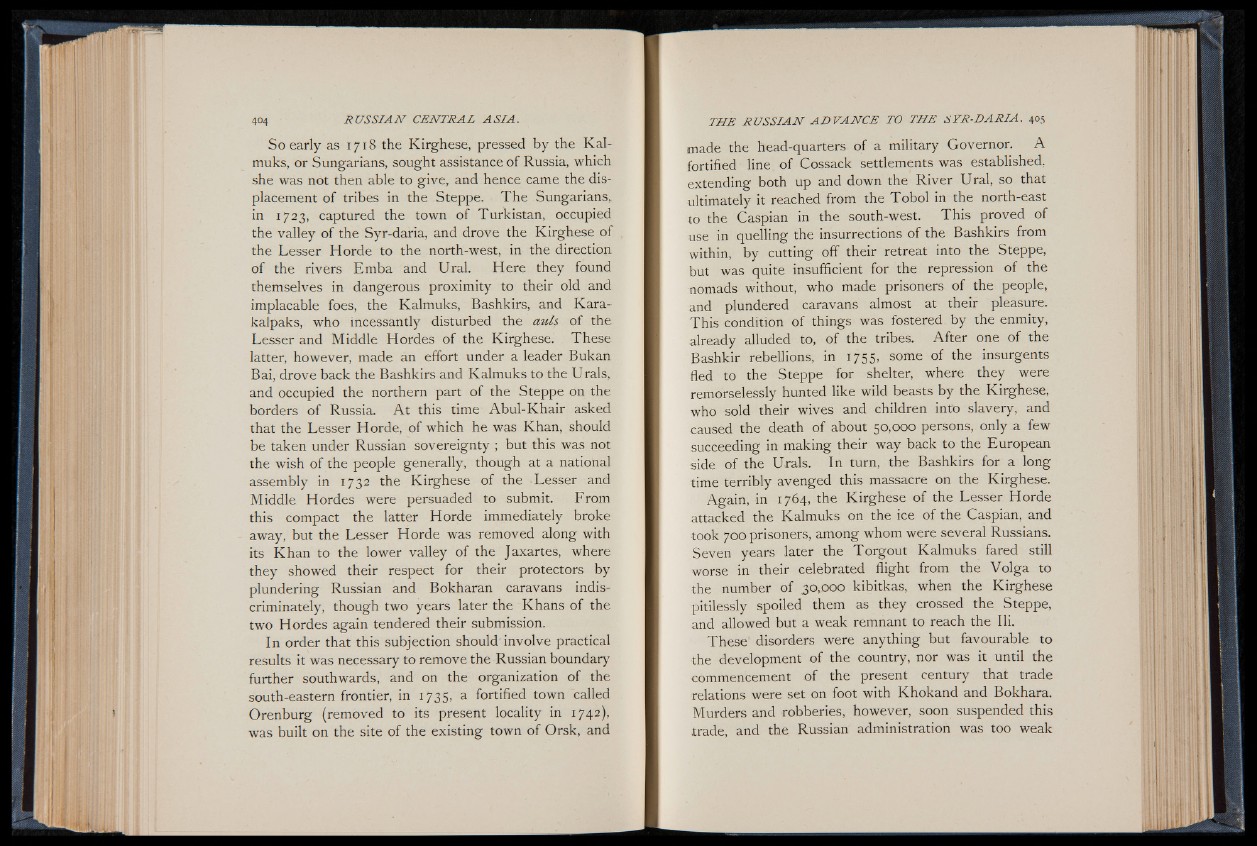
So early as 1718 the Kirghese, pressed by the Kal-
muks, or Sungarians, sought assistance of Russia, which
she was not then able to give, and hence came the displacement
of tribes in the Steppe. The Sungarians,
in 1723, captured the town of Turkistan, occupied
the valley of the Syr-daria, and drove the Kirghese of
the Lesser Horde to the north-west, in the direction
of the rivers Emba and Ural. Here they found
themselves in dangerous proximity to their old and
implacable foes, the Kalmuks, Bashkirs, and Kara-
kalpaks, who incessantly disturbed the auls of the
Lesser and Middle Hordes of the Kirghese. These
latter, however, made an effort under a leader Bukan
Bai, drove back the Bashkirs and Kalmuks to the Urals,
and occupied the northern part of the Steppe on the
borders of Russia. A t this time Abul-Khair asked
that the Lesser Horde, of which he was Khan, should
be taken under Russian sovereignty ; but this was not
the wish of the people generally, though at a national
assembly in 1732 the Kirghese of the Lesser and
Middle Hordes were persuaded to submit. From
this compact the latter Horde immediately broke
away, but the Lesser Horde was removed along with
its Khan to the lower valley of the Jaxartes, where
they showed their respect for their protectors by
plundering Russian and Bokharan caravans indiscriminately,
though two years later the Khans of the
two Hordes again tendered their submission.
In order that this subjection should involve practical
results it was necessary to remove the Russian boundary
further southwards, and on the organization of the
south-eastern frontier, in 1735, a fortified town called
Orenburg (removed to its present locality in 1742),
was built on the site of the existing town of Orsk, and
made the head-quarters of a military Governor. A
fortified line o f Cossack settlements was established,
extending both up and down the River Ural, so that
ultimately it reached from the Tobol in the north-east
to the Caspian in the south-west. This proved of
use in quelling the insurrections of the Bashkirs from
within, by cutting off their retreat into the Steppe,
but was quite insufficient for the repression of the
nomads without, who made prisoners of the people,
and plundered caravans almost at their pleasure.
This condition of things was fostered by the enmity,
already alluded to, of the tribes. After one of the
Bashkir rebellions, in 1755, some of the insurgents
fled to the Steppe for shelter, where they were
remorselessly hunted like wild beasts by the Kirghese,
who sold their wives and children into slavery, and
caused the death of about 50,000 persons, only a few
succeeding in making their way back to the European
side of the Urals. In turn, the Bashkirs for a long
time terribly avenged this massacre on the Kirghese.
Again, in 1764, the Kirghese of the Lesser Horde
attacked the Kalmuks on the ice of the Caspian, and
took 700 prisoners, among whom were several Russians.
Seven years later the Torgout Kalmuks fared still
worse in their celebrated flight from the Volga to
the number of 30,000 kibitkas, when the Kirghese
pitilessly spoiled them as they crossed the Steppe,
and allowed but a weak remnant to reach the Hi.
These disorders were anything but favourable to
the development of the country, nor was it until the
commencement of the present century that trade
relations were set on foot with Khokand and Bokhara.
Murders and robberies, however, soon suspended this
trade, and the Russian administration was too weak